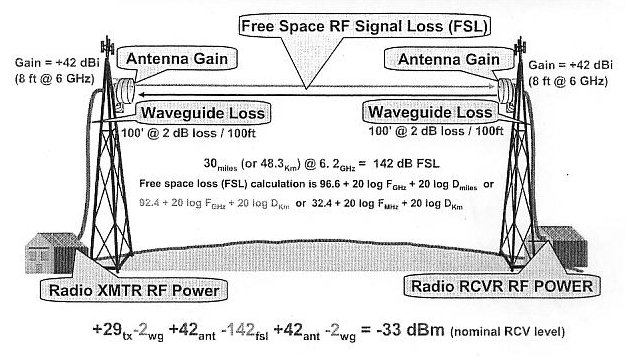Path loss
Radio Frequency (RF) signals need to get from one point to another to do any good for the transportation of intelligence.
This is done with an RF (modulated) transmitter, sending the signal to its antenna, so it will radiate into the air.
It's then picked up at the far end antenna, sent to a receiver and decoded/demodulated into audio to be understood by the receiving person.
All of this comes with gains and losses of the RF signal. In the case of microwave telecommunications a common practice for engineering uses
this process as shown on this typical drawing and other information obtained at various web sites:

The following rules are observed:
- calculation of received signal level (RSL)
- Unfaded RSL = Total Gains – Total Losses
- Total Gains
- Transmit power in dbm
- Antenna gains (transmit and receive)
- Free Space Loss in db
- Atmospheric absorption loss (oxygen and water vapor)
- Transmission line losses (waveguide and coaxial cable)
- Branching losses (circulators, filters, etc.)
- Antenna radome losses for standard antennas
- Hot standby splitter losses (1 db for 10:1 splitter)
- Transmit attenuators
System Gain (3 ds3 radio example above):
- +29 dbm (Tx) – (-71 dbm) 10-6 Tx min.) = 100 db
- (does not include antenna gain, free space loss or wg loss)
- (ATPC Disable – Space Diversity Receivers)
As in the case of VHF-UHF Amateur RF paths this can be somewhat simplified. More specifically, would be Amateur RF links.
- For calculation of received signal level (RSL)
- Unfaded RSL = Total Gains – Total Losses
- Total Gains
- Transmit power in dbm; i.e. +40dbm
- Antenna gains (transmit and receive); i.e. 6 db gain each = 12 db
Fade Margin
Fade Margin (FM) is the difference between the RSL and the squelch point of the far end receiver.
For practical circuits the receiver should "fail" the circuit in the event the path drops enough to raise the noise floor in the detected audio
no more than a 20 db signal to noise ratio, or a 20 dbm0 noise floor.
With most modern LMR receiver's this would be around a -100 dbm RF level.
Therefore, if this was observed as a standard squelch point the (above) RSL of -88 would produce a FM of 12 db.
To note, SRG specs call for a minimum FM of 20 db; 30 db being desirable. 

![[SRG home Direction]](images/srghome.gif)